ANE: In Conversation with: Laurie Norton Moffatt
Director/CEO
Norman Rockwell Museum
2020 has been called many things, both positive and extremely negative, with one of the most important being a wake-up call. I think it’s fair to say we are “awake,” as a nation, more than ever before and one need not look further than the early voting numbers for confirmation. There have been multiple campaigns to inspire the act of voting this year, sparking an impactful—and artful—dialogue. Talk shows, newscasters, educators and—most notably, as evidenced by the provocative and joyous new exhibition at the Norman Rockwell Museum (NRM)— artists have contributed to the massive effort driving voters to their mailboxes, drop boxes and (safely) into their polling stations on November 3rd.
Celebrate the experience of casting your ballot by visiting The Unity Project, a glorious addition to the Norman Rockwell: Imagining Freedom exhibit at the NRM in Stockbridge, MA, just two hours west of Boston, in the Berkshires. The exhibit reminds us how powerful our vote is and how privileged we are to express it. Spend a little time with these six pieces and allow each artist’s story to resonate. The strength behind their bold imagery, wit and humor will fortify us all for whatever lies ahead for the rest of 2021 and into the New Year—and a new beginning.
Art New England spoke with Laurie Norton Moffatt, director and CEO of the NRM, and the inspiration behind The Unity Project, which features six original “get out the vote” pieces commissioned from artists Mai Ly Degnan, Rudy Gutierrez, Anita Kunz, Tim O’Brien, Whitney Sherman and Yuko Shimizu.

Yuko Shimizu
Defend Democracy (Lady Liberty), 2020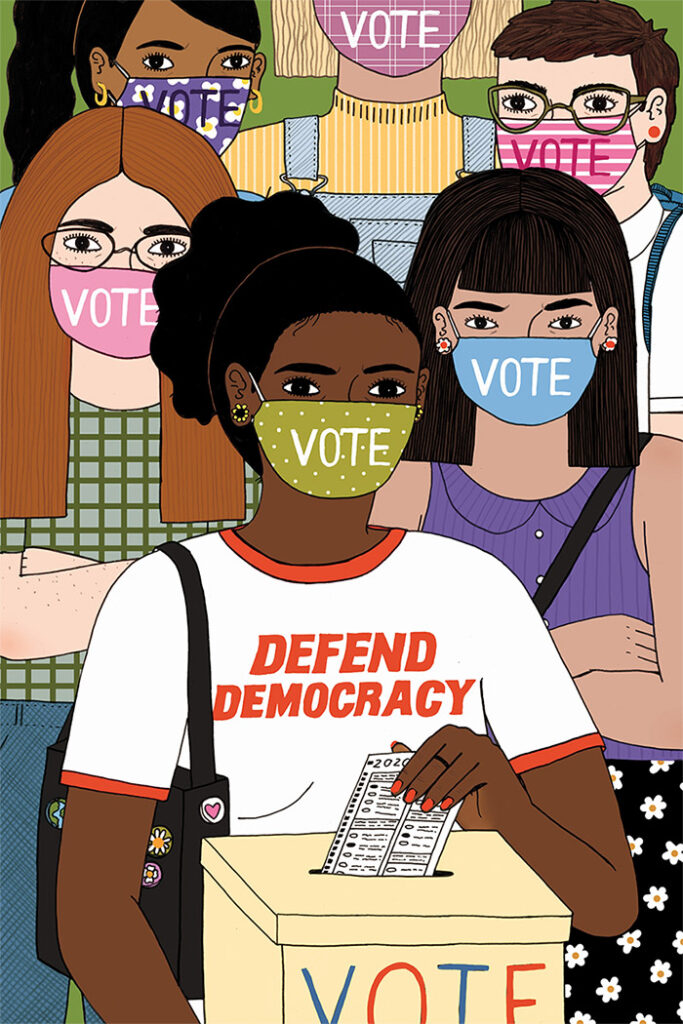
Mai Ly Degnan
Defend Democracy, 2020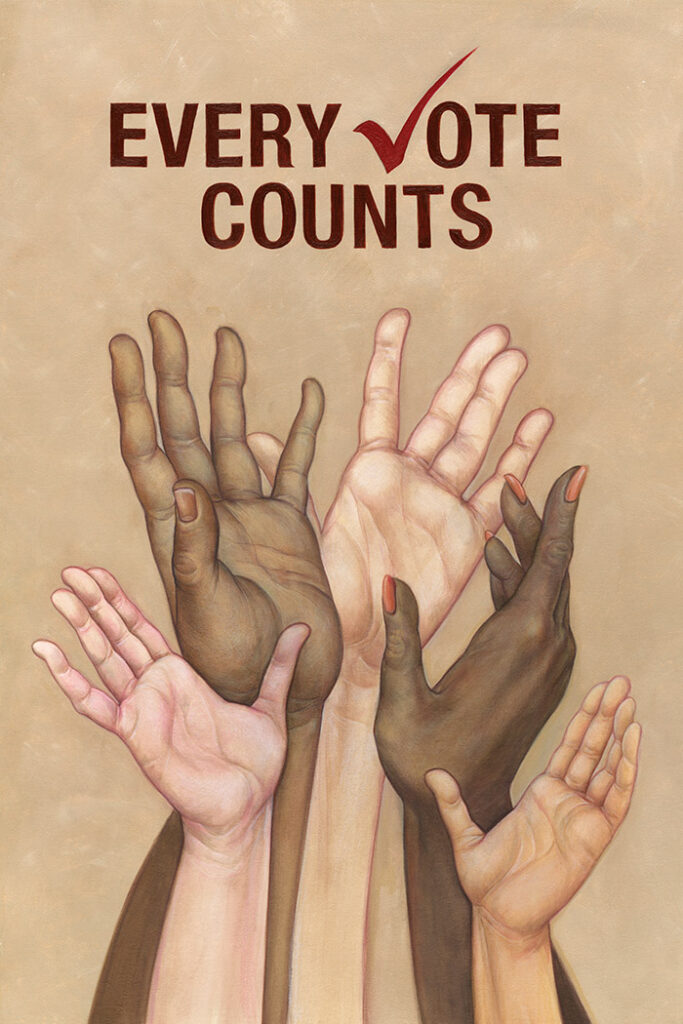
Anita Kunz
Every Vote Counts, 2020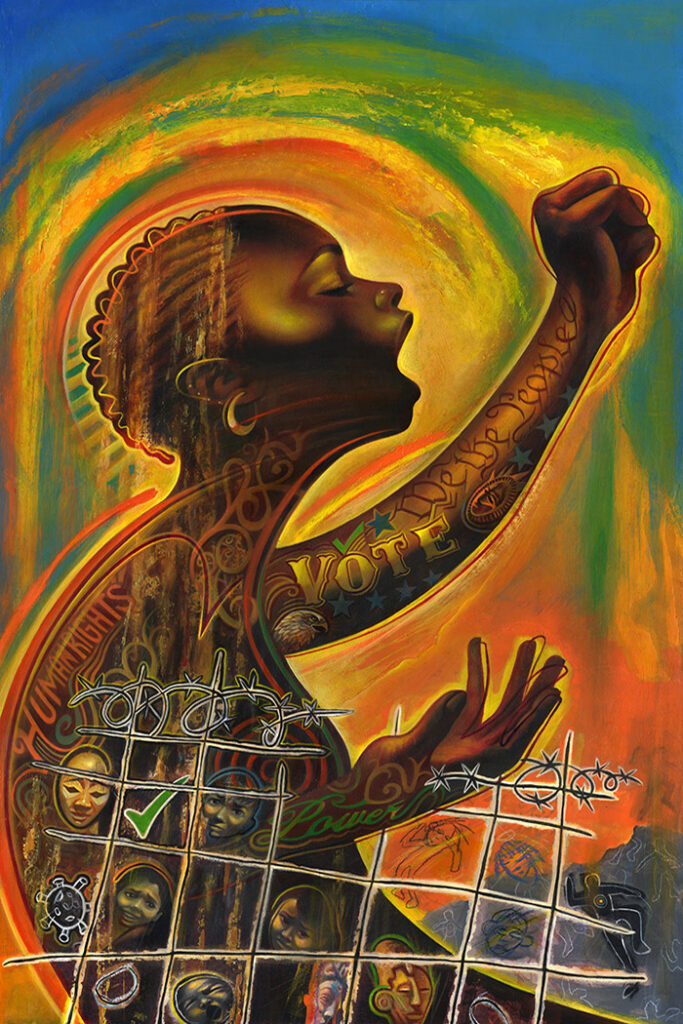
Rudy Gutierrez
Humanity, Not Politics, 2020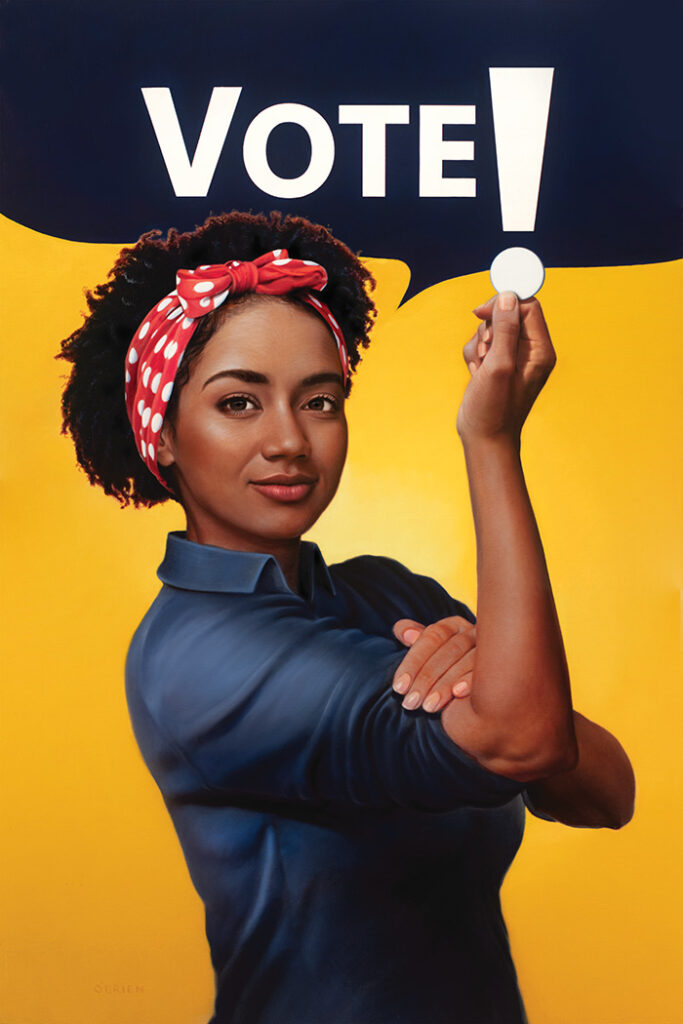
Tim O’Brien
Vote, 2020
Whitney Sherman
Vote: Defend Democracy, 2020
Art New England: What was the artist selection process like? Since the campaign came together in only six weeks, we’re curious if they’re all connected to the Museum in some way?
Norman Rockwell Museum has featured the artwork of hundreds of illustrators, developing close relationships with an extensive network of the finest illustrators of our times. We were able to reach out quickly to a range of artists and invite their participation. They were eager to participate.
When patrons expressed their idea to create a signature “Rosie the Riveter” image like Norman Rockwell and J. Howard Miller did in their days, to rally people across the country to service above self, and especially to vote, we responded with the idea of an invitation to leading illustrators. Our mutual goal was to find signature images that would appeal to a wide range of voters. The idea just sparked with all of us as a new way, using a traditional form of visual communication, to rally people around a major responsibility in our democracy and to inspire personal civic engagement.
Why did you feel both personally and professionally compelled to make such an extraordinary project come together at this time and so quickly?
I was personally passionate about The Unity Project as it combined two opportunities: to offer a fresh way for the Museum to reach in the digital space, at a time when physically visiting a museum is constrained by the global health pandemic, and to engage in the contemporary moment which puts illustration art to work in the world to reach millions of people, as Norman Rockwell did.
Our mission illuminates the power of American illustration to reflect and shape society. At a charged and emotional time of great polarization, it was appealing to work on a project that highlights something we all should hold in common, the right to vote. People respond to visual images. The concept offered a way to bring people together and motivate citizen engagement in a positive way.
There is such intensity in this moment, one could argue a desperation. Whereas we once sought out a museum experience for peace, solace, contemplation–and, of course, for provocative work that expands our minds and comfort zones—we’re now looking at our cultural institutions to spark not just a conversation but to put real, specific action behind the talk. Can you speak to the role museums play in this particular moment?
This moment invites us all to examine how to be an engaged and responsible citizen in the world, whether individually or as corporate citizens. Museums have traditionally been stewards of what is enduring across history and cultures. What museums collect reflects what we value. What museums present on their walls is what is deemed important to consider. The role of contemporary art often has a call to action. Illustration art particularly documents the moment and both reflects what we are thinking about and affects our actions.
Norman Rockwell Museum’s mission advances the enduring values of kindness, respect, and social equity. People often express how uplifted they feel after a visit to Norman Rockwell Museum. We aim to inspire hopefulness and joy, and the Unity Project offers hope for a future shaped by the voices of the people who exercise their agency and constitutional right to vote to elect their government. There is peace, solace, and contemplation, found in a world that makes space for everyone to have a voice through their vote.
The illustrations encapsulate so much: cultural diversity, a threatened democracy, the power of voting, women’s rights, patriotism, the pursuit of racial justice. In addition to the hope and inspiration the work instills, what other message(s) do you hope viewers can take away from this?
I hope that the Unity Project invites us each to reflect on what binds us in community, to consider what we hold and value in common, rather than focus energy on what divides us. It is also important for each of us to have a sense of agency, to appreciate that every vote matters, and that we have a voice in shaping the world we would like to live in. While it may be a cliché that a picture is worth a thousand words, at a time when so many people are shouting across each other over differences, perhaps an image might invite us to reflect upon and agree that the simple act of voting should not be taken for granted and must be protected for everyone.
Is there a specific piece that if one looked too quickly, they would miss something? Some special characteristic? Perhaps something that you’re particularly drawn to?
Yuko Shimizu’s Lady Liberty knocked me over. Yuko’s Lady Liberty is an energized modern superhero upholding America, her arm raised in strength, she reveals that her fist is a flaming torch, symbolic of this fiery contemporary moment. Wrapped in the American Flag, she sports a classic American Eagle tattoo, plus red nail polish! (A nod to the feminine of Rockwell’s Rosie the Riveter with her compact and lipstick.) She is all American.
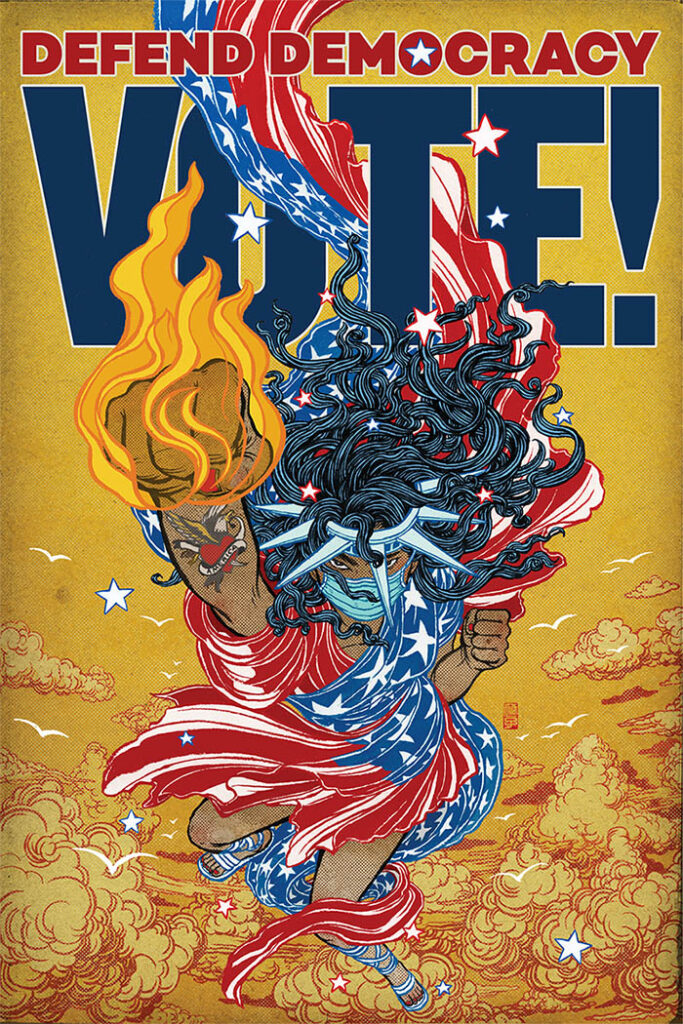
Yuko Shimizu, Defend Democracy (Lady Liberty), 2020
A close look at Lady Liberty reveals an image of a powerful defender of freedom, a woman who is both modern and classical in her mien. A swirling vortex of energy, Lady Liberty flies into our orbit as a contemporary superhero of immense power, an avatar of the nation’s symbolic Statue of Liberty, yet she reminds us of Howard Chandler Christie’s diaphanous Liberty Bond women of World War I, a century old tradition of motivational posters to inspire us to defend our country through thrift and investment to fight for freedom in the world. We note that this is also the 100th anniversary of women’s suffrage. Note her spiked crown adorning her wild locks framing the face of a powerful woman of color. This is HER time.
Look closely and you will see that she is wearing a medical mask, a bold maternal symbol protecting her citizens’ health and wellness during this time of global pandemic. Lady Liberty reminds us that we must fiercely defend the promise of freedom demanded not only in our Declaration of Independence which claims our right to the pursuit of life, liberty, and pursuit of happiness, but the symbolic promise of the Statue of Liberty to welcome immigrants to shores of to this land.
To this we add, Vote!
Art New England adds, at each opportunity.
Norman Rockwell: Imagining Freedom runs through May 31, 2021. Visit nrm.org for more information.
